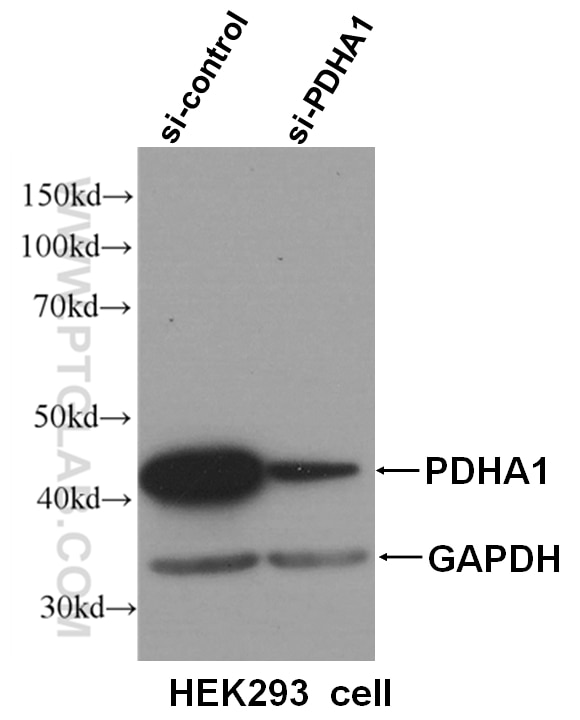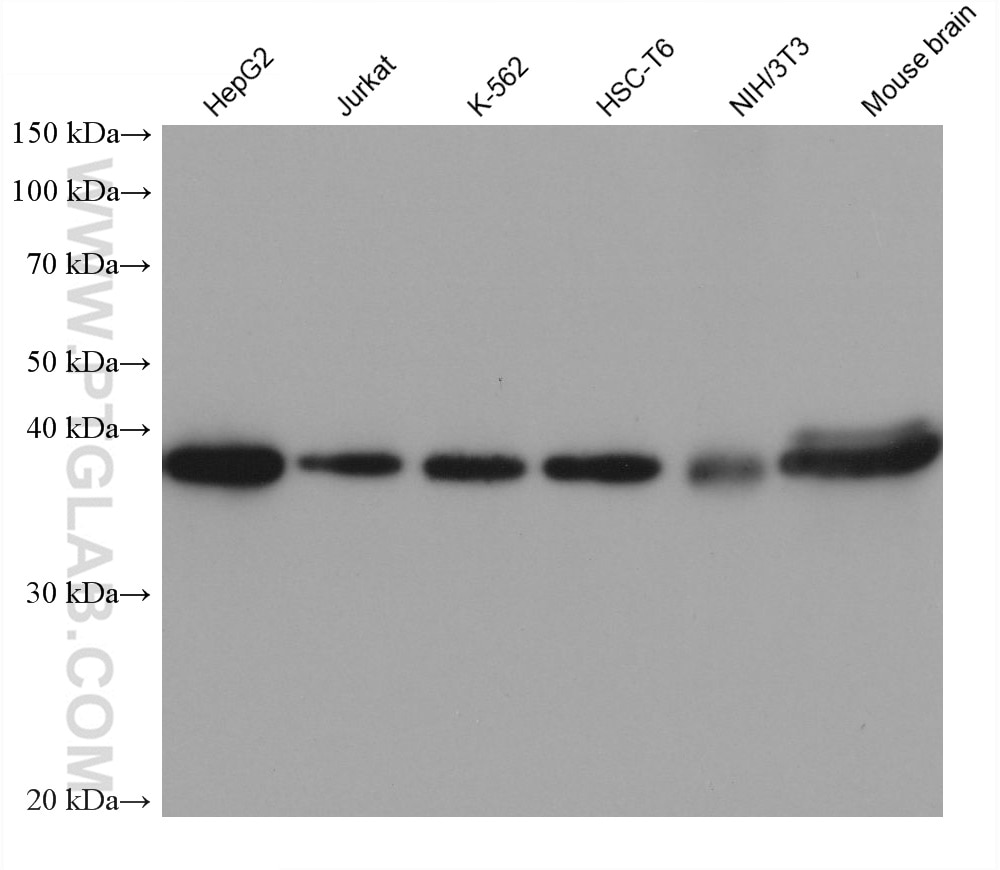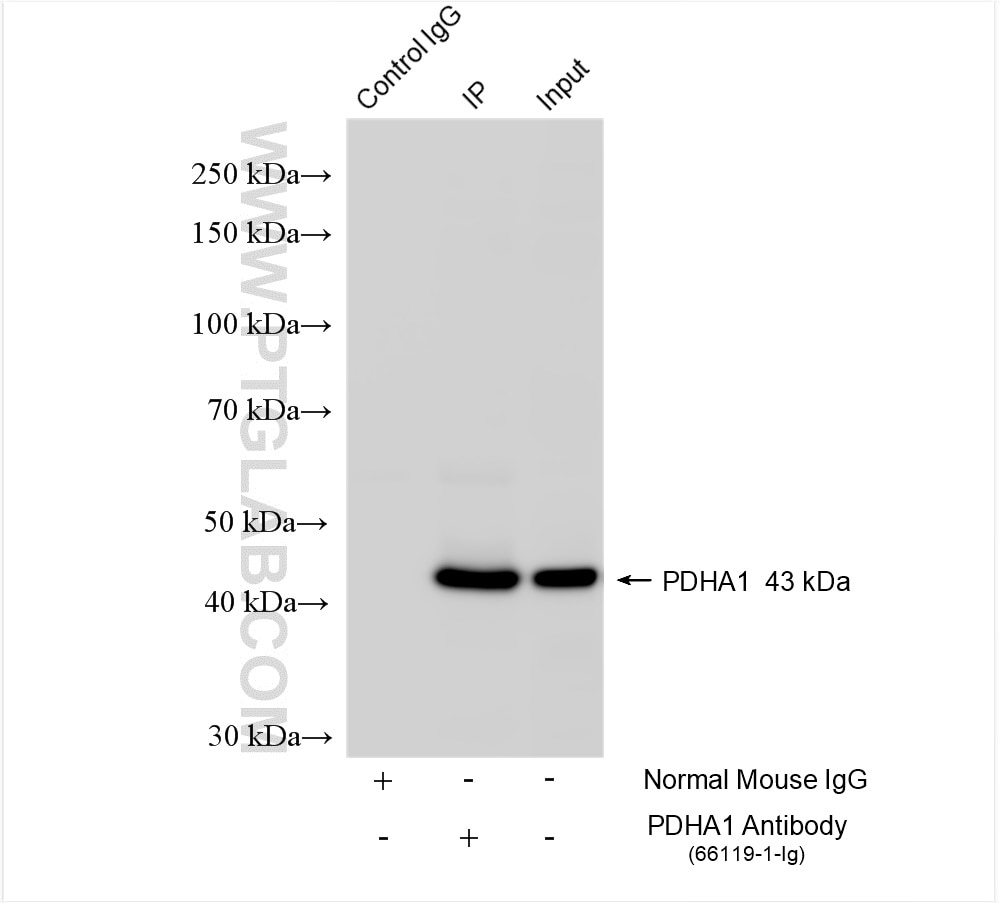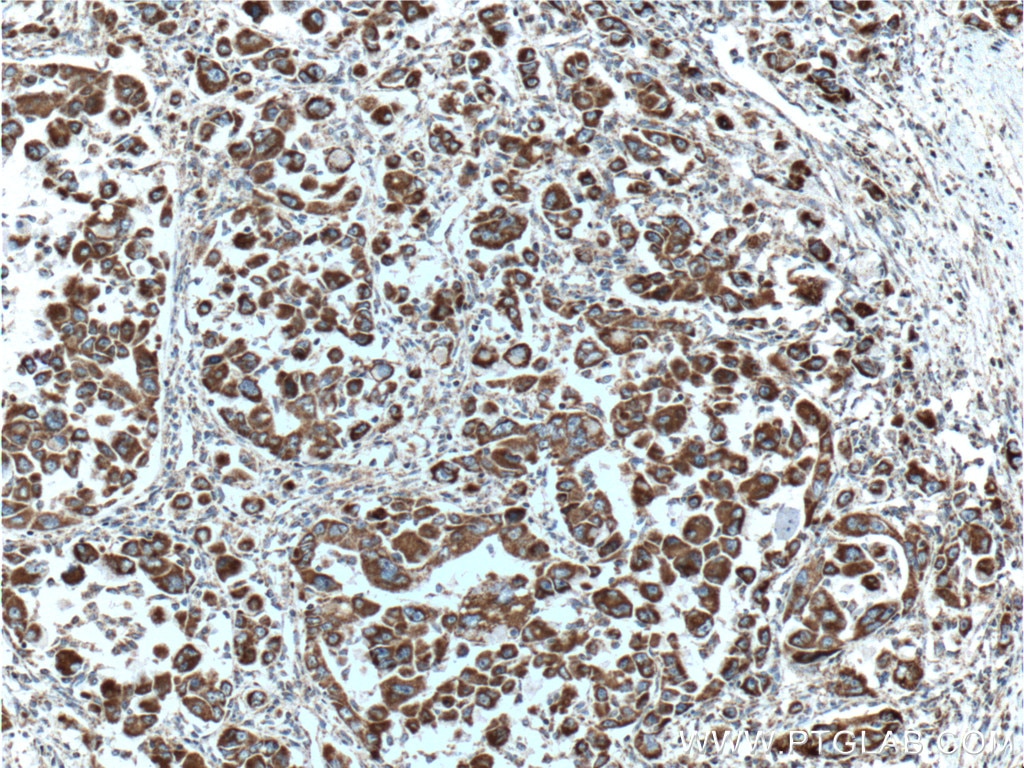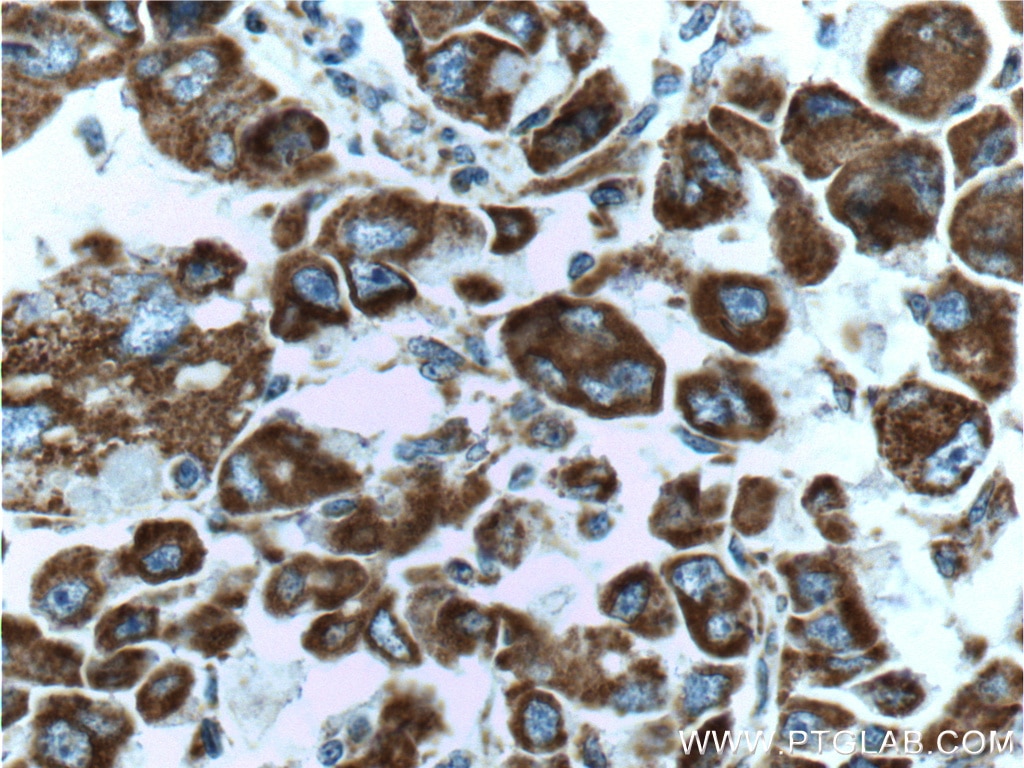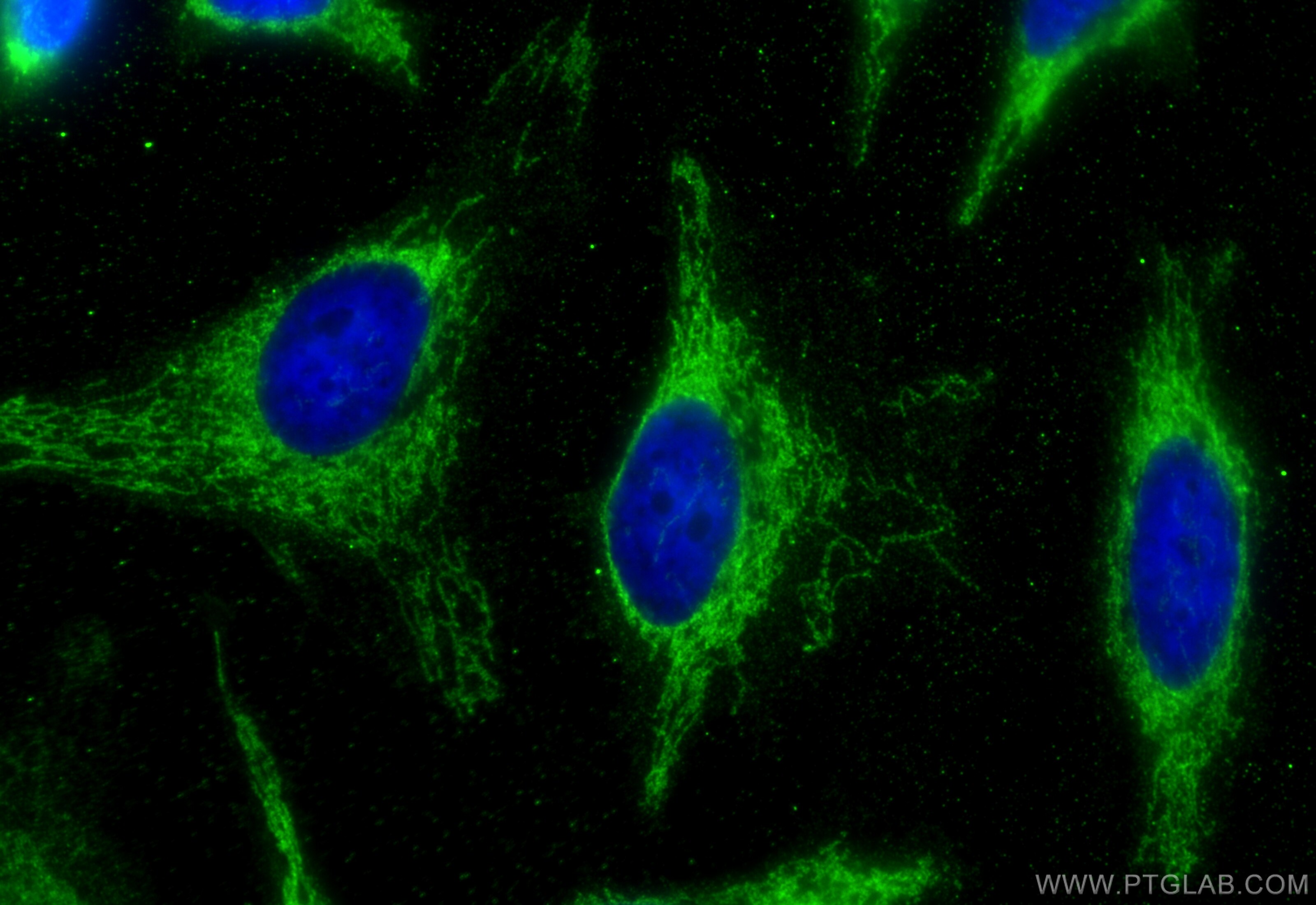Tested Applications
| Positive WB detected in | HepG2 cells, HEK293 cells, Jurkat cells, K-562 cells, HSC-T6 cells, NIH/3T3 cells, mouse brain tissue |
| Positive IP detected in | K-562 cells |
| Positive IHC detected in | human liver cancer tissue Note: suggested antigen retrieval with TE buffer pH 9.0; (*) Alternatively, antigen retrieval may be performed with citrate buffer pH 6.0 |
| Positive IF/ICC detected in | HeLa cells |
Recommended dilution
| Application | Dilution |
|---|---|
| Western Blot (WB) | WB : 1:5000-1:50000 |
| Immunoprecipitation (IP) | IP : 0.5-4.0 ug for 1.0-3.0 mg of total protein lysate |
| Immunohistochemistry (IHC) | IHC : 1:400-1:1600 |
| Immunofluorescence (IF)/ICC | IF/ICC : 1:400-1:1600 |
| It is recommended that this reagent should be titrated in each testing system to obtain optimal results. | |
| Sample-dependent, Check data in validation data gallery. | |
Published Applications
| KD/KO | See 1 publications below |
| WB | See 10 publications below |
| IF | See 1 publications below |
| IP | See 2 publications below |
Product Information
66119-1-Ig targets PDH E1 Alpha in WB, IHC, IF/ICC, IP, ELISA applications and shows reactivity with human, mouse, rat samples.
| Tested Reactivity | human, mouse, rat |
| Cited Reactivity | human |
| Host / Isotype | Mouse / IgG2a |
| Class | Monoclonal |
| Type | Antibody |
| Immunogen |
CatNo: Ag12556 Product name: Recombinant human PDHA1 protein Source: e coli.-derived, PET28a Tag: 6*His Domain: 41-390 aa of BC002406 Sequence: CDLHRLEEGPPVTTVLTREDGLKYYRMMQTVRRMELKADQLYKQKIIRGFCHLCDGQEACCVGLEAGINPTDHLITAYRAHGFTFTRGLSVREILAELTGRKGGCAKGKGGSMHMYAKNFYGGNGIVGAQVPLGAGIALACKYNGKDEVCLTLYGDGAANQGQIFEAYNMAALWKLPCIFICENNRYGMGTSVERAAASTDYYKRGDFIPGLRVDGMDILCVREATRFAAAYCRSGKGPILMELQTYRYHGHSMSDPGVSYRTREEIQEVRSKSDPIMLLKDRMVNSNLASVEELKEIDVEVRKEIEDAAQFATADPEPPLEELGYHIYSSDPPFEVRGANQWIKFKSVS Predict reactive species |
| Full Name | pyruvate dehydrogenase (lipoamide) alpha 1 |
| Calculated Molecular Weight | 43 kDa |
| Observed Molecular Weight | 39-48 kDa |
| GenBank Accession Number | BC002406 |
| Gene Symbol | PDHA1 |
| Gene ID (NCBI) | 5160 |
| RRID | AB_2881518 |
| Conjugate | Unconjugated |
| Form | Liquid |
| Purification Method | Protein A purification |
| UNIPROT ID | P08559 |
| Storage Buffer | PBS with 0.02% sodium azide and 50% glycerol, pH 7.3. |
| Storage Conditions | Store at -20°C. Stable for one year after shipment. Aliquoting is unnecessary for -20oC storage. 20ul sizes contain 0.1% BSA. |
Background Information
PDHA1(Pyruvate dehydrogenase E1 component subunit alpha, somatic form, mitochondrial) is also named as PHE1A.It is one of the 3 enzymes of the pyruvate dehydrogenase complex which is a nuclear-encoded mitochondrial matrix multienzyme complex that provides the primary link between glycolysis and the tricarboxylic acid (TCA) cycle by catalyzing the irreversible conversion of pyruvate into acetyl-CoA(PMID:7853374).It has 4 isoforms produced by alternative splicing.Defects in PDHA1 are a cause of pyruvate dehydrogenase E1-alpha deficiency (PDHAD) and X-linked Leigh syndrome (X-LS).
Protocols
| Product Specific Protocols | |
|---|---|
| IF protocol for PDH E1 Alpha antibody 66119-1-Ig | Download protocol |
| IHC protocol for PDH E1 Alpha antibody 66119-1-Ig | Download protocol |
| IP protocol for PDH E1 Alpha antibody 66119-1-Ig | Download protocol |
| WB protocol for PDH E1 Alpha antibody 66119-1-Ig | Download protocol |
| Standard Protocols | |
|---|---|
| Click here to view our Standard Protocols |
Publications
| Species | Application | Title |
|---|---|---|
Nat Commun Lin28/let-7 axis regulates aerobic glycolysis and cancer progression via PDK1. | ||
J Cell Biol PINK1 disables the anti-fission machinery to segregate damaged mitochondria for mitophagy. | ||
Cell Rep A LON-ClpP Proteolytic Axis Degrades Complex I to Extinguish ROS Production in Depolarized Mitochondria. | ||
Oxid Med Cell Longev NOX4-Derived ROS Mediates TGF- β 1-Induced Metabolic Reprogramming during Epithelial-Mesenchymal Transition through the PI3K/AKT/HIF-1 α Pathway in Glioblastoma | ||
Toxicol Appl Pharmacol Sodium cantharidate induces Apoptosis in breast cancer cells by regulating energy metabolism via the protein phosphatase 5-p53 axis. | ||
Immunobiology The mTOR-glycolytic pathway promotes T-cell immunobiology in oral lichen planus. |

